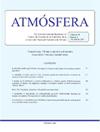土耳其中黑海地区区域极端降水估计
IF 1
4区 地球科学
Q4 METEOROLOGY & ATMOSPHERIC SCIENCES
引用次数: 0
摘要
暴雨引发洪水事件的发生概率对水相关设施的设计和水资源管理具有重要作用。在许多情况下,用于分析的数据要么无法获得,要么不足以可靠地设计与水有关的结构。在数据特别不足的场址,往往更倾向于采用区域频率分析来提供设计资料。本研究对土耳其黑海中部地区(MBSR) 70个测量站的年最大降雨量序列实施l矩程序,以估计区域降雨量分位数。区域化的第一次尝试是将整个地区评价为唯一的同质区域。子区域最初是用病房的聚类算法定义的,因为在单一均匀区域的假设下存在不一致的站点。根据不一致性和异质性测量的结果,6个集群(子区域)是最有希望的分类。子区域满足同质性条件为“可接受的同质性”。5个次区域的GEV和GLO分布、4个次区域的GNO分布和3个次区域的PE3分布被确定为可接受的区域频率分布。相比之下,GPA在六个子区域中都不是候选分布。本文章由计算机程序翻译,如有差异,请以英文原文为准。
Regional extreme rainfall estimation in Middle Black Sea Region, Turkey
The occurrence probabilities of heavy rainfalls brought about flood events have an essential role in designing water-related structures and water resource management. In many cases, data for analysis are either not available or are insufficient for reliable design of water-related structures. Regional frequency analysis is frequently preferred to provide design information at sites with especially inadequate data available. Our study implemented L-moment procedures to annual maximum rainfall series from 70 gauging stations in the Middle Black Sea Region (MBSR) in Turkey to estimate regional rainfall quantiles. The first attempt for regionalization was to evaluate the entire area as an only homogeneous region. The sub-regions were initially defined with the ward’s clustering algorithm due to the presence of discordant sites under a presumption of a single homogeneous region. In compliance with the results of the discordancy and heterogeneity measures, the most promising classification was achieved with 6 clusters (sub-regions). The sub-regions have satisfied the homogeneity condition as “acceptably homogeneous.” The GEV and GLO distributions in five sub-regions, GNO distribution in four sub-regions, and PE3 distribution in three sub-regions were decided to be acceptable as a regional frequency distribution. In comparison, GPA is a candidate distribution in none of six sub-regions.
求助全文
通过发布文献求助,成功后即可免费获取论文全文。
去求助
来源期刊

Atmosfera
地学-气象与大气科学
CiteScore
2.20
自引率
0.00%
发文量
46
审稿时长
6 months
期刊介绍:
ATMÓSFERA seeks contributions on theoretical, basic, empirical and applied research in all the areas of atmospheric sciences, with emphasis on meteorology, climatology, aeronomy, physics, chemistry, and aerobiology. Interdisciplinary contributions are also accepted; especially those related with oceanography, hydrology, climate variability and change, ecology, forestry, glaciology, agriculture, environmental pollution, and other topics related to economy and society as they are affected by atmospheric hazards.
 求助内容:
求助内容: 应助结果提醒方式:
应助结果提醒方式:


